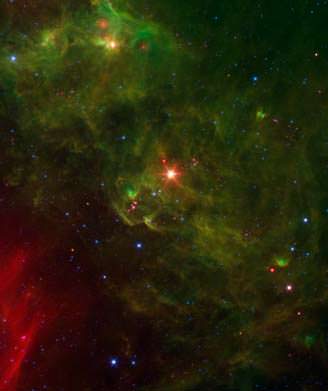[/caption]
This week at the AAS meeting scientists revealed two new studies on a star forming region in Vela. The first used the Balloon-borned Large Aperture Submillimeter Telescope (BLAST, a proptotype detector for the one on the new Herschel Space Telescope) to classify the young stars and begin mapping the warm dust in the region. The second searched the nebula for flaring young stars. Both studies are to appear in an upcoming publication of the Astrophysical Journal.
Although star formation has been well modeled and understood theoretically, observational astronomy is often made more difficult due to the fact that it occurs shrouded in dusty nebulae. Visible light absorbed by the nebula and reemitted as lower energy infrared light. Most of the wavelengths in this region cannot permeate Earth’s atmosphere.
In order to study regions like this, astronomers are forced to use balloon based and space observatories. Astronomers Massimo Marengo, Giovanni Fazio, and Howard Smith, together with an international team of scientists used BLAST to study just such a star forming region in Vela. The first of their studies searched the nebula for newly formed stars. To do this, they searched for behaviors shown to be indicative of star formation, “such as proto-stellar jets and molecular outflows.” Additionally, to truly classify as a proto-star, the object was required to show up at more than one wavelength. In searching for these candidates, they confirmed 13 cores originally reported by a previous team, but discounted one because it did not have the proper spectral characteristics (although they may still later collapse to form stars).
By analyzing the mass of the forming regions, the team was also able to show that the Core Mass Function (CMF, a function that describes the frequencies of proto-star cores of various masses) is very similar to the Initial Mass Function (IMF, which is the same thing but for already formed stars). Although this is unsurprising, it is a necessary observation to confirm our understanding of how stars form and to show that stars do indeed come from such nebulae.
Another unsurprising confirmation of stellar formation models is that forming cores in the nebula are notably warmer when they’ve reached the density sufficient to create fusion in the core and have an embedded protostar. These results, “can thus provide guidelines
for understanding the physical conditions where the transition between pre- and proto-stellar cores takes place.”
The second of their studies analyzed known young stars to search for large flares thought to be caused by material being accreted onto the young star. The region was imaged once and then a second time six months later. Over this period, 47 of some 170,000 observed stars had increases in brightness consistent with what was expected for flaring. Closer inspection of these stars 19 had the further characteristics (mass, age, environment) expected of such flares. Eight showed evidence of being extremely young (on the order of a hundred thousand years or less) and were still enshrouded in gravitationally bound disks of dust.
Although this cannot confirm the prediction of such youthful flares being due to infalling material (as opposed to magnetic fields or interactions with a companion) it does show that BLAST and its successor, Herschel, will be a powerful tool for further study.


“…a proptotype detector for the one to be placed on the new Herschel Space Telescope…”
Considering that the Herschel Space Telescope is currently at a Lagrange point, won’t it be difficult to put a new instrument on it?
You’re right Tim. I wasn’t up on how far Herschel was along and thought originally it was still being prepared. I fixed that in one part but not that one apparently. My mistake.
Thanks for catching it.